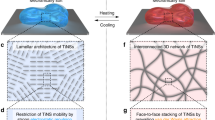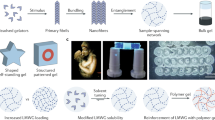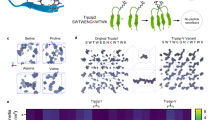Abstract
Some animals form transient, responsive and solid-like ensembles through dynamic structural interactions. These ensembles demonstrate emergent responses such as spontaneous self-assembly, which are difficult to achieve in synthetic soft matter. Here we use shape-morphing units comprising responsive polymers to create solids that self-assemble, modulate their volume and disassemble on demand. The ensemble is composed of a responsive hydrogel, liquid crystal elastomer or semicrystalline polymer ribbons that reversibly bend or twist. The dispersions of these ribbons mechanically interlock, inducing reversible aggregation. The aggregated liquid crystal elastomer ribbons have a 12-fold increase in the yield stress compared with cooled dispersion and contract by 34% on heating. Ribbon type, concentration and shape dictate the aggregation and govern the global mechanical properties of the solid that forms. Coating liquid crystal elastomer ribbons with a liquid metal begets photoresponsive and electrically conductive aggregates, whereas seeding cells on hydrogel ribbons enables self-assembling three-dimensional scaffolds, providing a versatile platform for the design of dynamic materials.
This is a preview of subscription content, access via your institution
Access options
Access Nature and 54 other Nature Portfolio journals
Get Nature+, our best-value online-access subscription
$29.99 / 30 days
cancel any time
Subscribe to this journal
Receive 12 print issues and online access
$259.00 per year
only $21.58 per issue
Buy this article
- Purchase on Springer Link
- Instant access to full article PDF
Prices may be subject to local taxes which are calculated during checkout





Similar content being viewed by others
Data availability
Data supporting the findings of this study are available in the Article and the Supplementary Information. Source data are provided with this paper.
References
Diller, E., Zhang, N. & Sitti, M. Modular micro-robotic assembly through magnetic actuation and thermal bonding. J. Micro-Bio Robot. 8, 121–131 (2013).
Yang, X., Tan, R., Lu, H., Fukuda, T. & Shen, Y. Milli-scale cellular robots that can reconfigure morphologies and behaviors simultaneously. Nat. Commun. 13, 4156 (2022).
Fan, X., Dong, X., Karacakol, A. C., Xie, H. & Sitti, M. Reconfigurable multifunctional ferrofluid droplet robots. Proc. Natl Acad. Sci. USA 117, 27916–27926 (2020).
Hu, D. L., Phonekeo, S., Altshuler, E. & Brochard-Wyart, F. Entangled active matter: from cells to ants. Eur. Phys. J. Spec. Top. 225, 629–649 (2016).
Vernerey, F. J. et al. Biological active matter aggregates: inspiration for smart colloidal materials. Adv. Colloid Interface Sci. 263, 38–51 (2019).
Metzmacher, J., Poty, M., Lumay, G. & Vandewalle, N. Self-assembly of smart mesoscopic objects. Eur. Phys. J. E 40, 108 (2017).
Dierichs, K. & Menges, A. Towards an aggregate architecture: designed granular systems as programmable matter in architecture. Granular Matter 18, 25 (2016).
Wagner, R. J., Such, K., Hobbs, E. & Vernerey, F. J. Treadmilling and dynamic protrusions in fire ant rafts. J. R. Soc. Interface 18, 20210213 (2021).
Grozinger, C. M., Richards, J. & Mattila, H. R. From molecules to societies: mechanisms regulating swarming behavior in honey bees (Apis spp.). Apidologie 45, 327–346 (2014).
Patil, V. P. et al. Ultrafast reversible self-assembly of living tangled matter. Science 380, 392–398 (2023).
Mlot, N. J., Tovey, C. A. & Hu, D. L. Fire ants self-assemble into waterproof rafts to survive floods. Proc. Natl. Acad. Sci. USA 108, 7669–7673 (2011).
Anderson, C., Theraulaz, G. & Deneubourg, J.-L. Self-assemblages in insect societies. Insect Soc. 49, 99–110 (2002).
Ozkan-Aydin, Y., Goldman, D. I. & Bhamla, M. S. Collective dynamics in entangled worm and robot blobs. Proc. Natl. Acad. Sci. USA 118, e2010542118 (2021).
Tennenbaum, M., Liu, Z., Hu, D. & Fernandez-Nieves, A. Mechanics of fire ant aggregations. Nat. Mater. 15, 54–59 (2016).
Foster, P. C., Mlot, N. J., Lin, A. & Hu, D. L. Fire ants actively control spacing and orientation within self-assemblages. J. Exp. Biol. 217, 2089–2100 (2014).
Tennenbaum, M. & Fernandez-Nieves, A. Activity-driven changes in the mechanical properties of fire ant aggregations. Phys. Rev. E 96, 052601 (2017).
Deblais, A., Woutersen, S. & Bonn, D. Rheology of entangled active polymer-like T. tubifex worms. Phys. Rev. Lett. 124, 188002 (2020).
Weiner, N., Bhosale, Y., Gazzola, M. & King, H. Mechanics of randomly packed filaments—the ‘bird nest’ as meta-material. J. Appl. Phys. 127, 050902 (2020).
Mezeix, L., Bouvet, C., Huez, J. & Poquillon, D. Mechanical behavior of entangled fibers and entangled cross-linked fibers during compression. J. Mater. Sci. 44, 3652–3661 (2009).
Rodney, D., Gadot, B., Martinez, O. R., Roscoat, S. Rdu & Orgéas, L. Reversible dilatancy in entangled single-wire materials. Nat. Mater. 15, 72–77 (2016).
Murphy, K. A., Reiser, N., Choksy, D., Singer, C. E. & Jaeger, H. M. Freestanding loadbearing structures with Z-shaped particles. Granular Matter 18, 26 (2016).
Xin, S., Chimene, D., Garza, J. E., Gaharwar, A. K. & Alge, D. L. Clickable PEG hydrogel microspheres as building blocks for 3D bioprinting. Biomater. Sci. 7, 1179–1187 (2019).
Muir, V. G. et al. Sticking together: injectable granular hydrogels with increased functionality via dynamic covalent inter‐particle crosslinking. Small 18, e2201115 (2022).
Buttinoni, I. et al. Dynamical clustering and phase separation in suspensions of self-propelled colloidal particles. Phys. Rev. Lett. 110, 238301 (2013).
Lazarus, C., Pouliopoulos, A. N., Tinguely, M., Garbin, V. & Choi, J. J. Clustering dynamics of microbubbles exposed to low-pressure 1-MHz ultrasound. J. Acoust. Soc. Am. 142, 3135–3146 (2017).
Xie, H. et al. Reconfigurable magnetic microrobot swarm: multimode transformation, locomotion, and manipulation. Sci. Robot. 4, eaav8006 (2019).
Yan, J. et al. Reconfiguring active particles by electrostatic imbalance. Nat. Mater. 15, 1095–1099 (2016).
Lin, Z. et al. Light‐activated active colloid ribbons. Angew. Chem. 129, 13702–13705 (2017).
Kessel, B. et al. 3D bioprinting of macroporous materials based on entangled hydrogel microstrands. Adv. Sci. 7, 2001419 (2020).
Behl, M., Kratz, K., Zotzmann, J., Nöchel, U. & Lendlein, A. Reversible bidirectional shape-memory polymers. Adv. Mater. 25, 4466–4469 (2013).
Gladman, A. S., Matsumoto, E. A., Nuzzo, R. G., Mahadevan, L. & Lewis, J. A. Biomimetic 4D printing. Nat. Mater. 15, 413–418 (2015).
Yakacki, C. M. et al. Tailorable and programmable liquid-crystalline elastomers using a two-stage thiol–acrylate reaction. RSC Adv. 5, 18997–19001 (2015).
Sawa, Y. et al. Shape selection of twist-nematic-elastomer ribbons. Proc. Natl. Acad. Sci. USA 108, 6364–6368 (2011).
Lee, K. M., Bunning, T. J. & White, T. J. Autonomous, hands‐free shape memory in glassy, liquid crystalline polymer networks. Adv. Mater. 24, 2839–2843 (2012).
Zhao, Y. et al. Twisting for soft intelligent autonomous robot in unstructured environments. Proc. Natl. Acad. Sci. USA 119, e2200265119 (2022).
Zhang, Y. et al. Seamless multimaterial 3D liquid-crystalline elastomer actuators for next-generation entirely soft robots. Sci. Adv. 6, eaay8606 (2020).
Haan, L. T., de, Schenning, A. P. H. J. & Broer, D. J. Programmed morphing of liquid crystal networks. Polymer 55, 5885–5896 (2014).
Wagner, R. J. & Vernerey, F. J. Computational exploration of treadmilling and protrusion growth observed in fire ant rafts. PLoS Comput. Biol. 18, e1009869 (2022).
Javed, M. et al. Programmable shape change in semicrystalline liquid crystal elastomers. ACS Appl. Mater. Interfaces 14, 35087–35096 (2022).
Cook, M. T., Haddow, P., Kirton, S. B. & McAuley, W. J. Polymers exhibiting lower critical solution temperatures as a route to thermoreversible gelators for healthcare. Adv. Funct. Mater. 31, 2008123 (2021).
Wang, Q. et al. Lightweight mechanical metamaterials with tunable negative thermal expansion. Phys. Rev. Lett. 117, 175901 (2016).
Minh, N. H. & Cheng, Y. P. On the contact force distributions of granular mixtures under 1D-compression. Granular Matter 18, 18 (2016).
Liu, A. J. & Nagel, S. R. The jamming transition and the marginally jammed solid. Annu. Rev. Condens. Matter Phys. 1, 347–369 (2010).
Chechetka, S. A. et al. Light-driven liquid metal nanotransformers for biomedical theranostics. Nat. Commun. 8, 15432 (2017).
Ford, M. J. et al. A multifunctional shape-morphing elastomer with liquid metal inclusions. Proc. Natl. Acad. Sci. USA 116, 21438–21444 (2019).
Tavakoli, M. et al. EGaIn‐assisted room‐temperature sintering of silver nanoparticles for stretchable, inkjet‐printed, thin‐film electronics. Adv. Mater. 30, 1801852 (2018).
Urayama, K., Okuno, Y. & Kohjiya, S. Volume transition of liquid crystalline gels in isotropic solvents. Macromolecules 36, 6229–6234 (2003).
Gelebart, A. H. et al. Photoresponsive sponge‐like coating for on‐demand liquid release. Adv. Funct. Mater. 28, 1705942 (2018).
Yao, C. et al. Poly(N‐isopropylacrylamide)‐clay nanocomposite hydrogels with responsive bending property as temperature‐controlled manipulators. Adv. Funct. Mater. 25, 2980–2991 (2015).
Zhang, J., Zheng, L., Wu, Z., Wang, L. & Li, Y. Thermoresponsive bilayer hydrogel with switchable bending directions as soft actuator. Polymer 253, 124998 (2022).
Shu, X. Z. et al. Attachment and spreading of fibroblasts on an RGD peptide–modified injectable hyaluronan hydrogel. J. Biomed. Mater. Res. A 68A, 365–375 (2004).
Beaman, H. T. et al. Hemostatic shape memory polymer foams with improved survival in a lethal traumatic hemorrhage model. Acta Biomater. 137, 112–123 (2022).
Landsman, T. L. et al. Design and verification of a shape memory polymer peripheral occlusion device. J. Mech. Behav. Biomed. Mater. 63, 195–206 (2016).
Dinkgreve, M., Paredes, J., Denn, M. M. & Bonn, D. On different ways of measuring ‘the’ yield stress. J. Non-Newtonian Fluid Mech. 238, 233–241 (2016).
Perge, C., Taberlet, N., Gibaud, T. & Manneville, S. Time dependence in large amplitude oscillatory shear: a rheo-ultrasonic study of fatigue dynamics in a colloidal gel. J. Rheol. 58, 1331–1357 (2014).
Acknowledgements
This material is based on the work supported by the Army Research Office under grant no. W911NF1810150; National Science Foundation under grant nos. 2041671, 2147830 and 2023179; and the Dr Dionel E. Avilés ‘53 and Dr James E. Johnson ‘67 Graduate Fellowships. A.K.G. acknowledges financial support from the National Institute of Biomedical Imaging and Bioengineering (NIBIB) of NIH, the Director’s New Innovator award (DP2 EB026265), Peer Reviewed Medical Research Program (PRMRP) of the Department of Defense (DOD) (W81XWH2210932) and the President’s Excellence Fund (X-Grants) from Texas A&M University. We would also like to acknowledge the Cardiovascular Pathology Laboratory at Texas A&M University (CVP-TAMU) for the micro-computed tomography imaging and analysis. We acknowledge the use of the Materials Characterization Facility at Carnegie Mellon University supported by grant MCF-677785. We would also like to thank S. Bergbreiter for the use of her lab’s Phenom scanning electron microscope. We would also like to acknowledge K.J. Weishaar for intellectual discussions. This article corresponds to information release no. LLNL-JRNL-843254.
Author information
Authors and Affiliations
Contributions
M.K.A. and T.H.W. designed the research. M.K.A. conducted most of the experiments. R.J.W. and F.J.V. performed the simulations. M.S.K., M.Z. and C.M. performed and/or designed the experiments involving conductive ribbons. L.K.J. performed the experiments involving micro-computed tomography imaging. M.S.K., S.W., M.J. and A.D. assisted with the experiments involving mechanical testing. A.K.G., M.H.K. and K.A.S. performed and/or designed the experiments involving cell seeding. A.K.G. and S.E.H. performed and/or designed the experiments involving blood clotting. The Article was written through the contributions of all authors. All authors have given approval to the final version of the Article.
Corresponding author
Ethics declarations
Competing interests
The authors declare no competing interests.
Peer review
Peer review information
Nature Materials thanks Christopher Yakacki and the other, anonymous, reviewer(s) for their contribution to the peer review of this work.
Additional information
Publisher’s note Springer Nature remains neutral with regard to jurisdictional claims in published maps and institutional affiliations.
Extended data
Extended Data Fig. 1 Overlap-dependent network aggregation.
a, A schematic of two ribbons with nominal separation \(\sqrt{{c}^{-1}}\) and length \(L\) defines the measures governing \({\mathscr{O}}\). b, Phase space of \({\mathscr{O}}\) for the range of ribbon separations, \(\sqrt{{c}^{-1}}\), and reaches, \(L/2\), investigated through the Monte Carlo model is presented. The heat map represents \({\mathscr{O}}{\mathscr{\in }}\left[\mathrm{1,1.12}\right]\) such that the regime for which \({\mathscr{O}} > 1.12\) is depicted in yellow, while the regime for which \({\mathscr{O}} < 1\) (wherein percolation is impossible) is depicted in blue. The red line represents the phase boundary to the left of which percolation occurred at least 50% (\(P\ge 0.5\)) of the time when visually determined over \(n=10\) simulations for each parameter combination. c-e, Monte Carlo networks and snapshots of the real system composed of LCE ribbons with an offset angle of 10° at 25 °C (left) and after heating to 175 °C (right) are shown for c, \(L=6\) mm, \(\sqrt{{c}^{-1}}\approx 1.6\) mm (\({\mathscr{O}} > 1.12\)); d, \(L=6\) mm, \(\sqrt{{c}^{-1}}\approx 3\) mm (\({\mathscr{O}} < 1.12\)); and e, \(L=8\) mm, \(\sqrt{{c}^{-1}}\approx 3\) mm (\({\mathscr{O}} > 1.12\)). f,e, Monte Carlo networks and snapshots of the real system composed of bilayer hydrogel ribbons at 25 °C (left) and after heating to 37 °C (right) are shown for f, \(L=5\) mm, \(\sqrt{{c}^{-1}}\approx 1.5\) mm (\({\mathscr{O}}{\mathscr{ < }}1.12\)); and g, \(L=10\) mm, \(\sqrt{{c}^{-1}}\approx 2\) mm (\({\mathscr{O}} > 1.12\)). Unlike the reach of LCE ribbons, the reach of hydrogel ribbons decreases by approximately 50% as a function of temperature due to deswelling (Supplementary Fig. 5).
Extended Data Fig. 2 Semicrystalline LCE aggregates can withstand tensile loads.
a, Timelapse photographs of tensile test of a representative sample of an aggregate created from semicrystalline LCEs at strains of 0%, 50%, 100%, 150%, and 200% (Scale bar = 6 mm). b, Stress plotted as a function of strain of semicrystalline aggregates. Tests were performed 3 times, using 3 separate samples of aggregated semicrystalline LCEs. All plots are shown.
Supplementary information
Supplementary Information
Supplementary Notes 1–5, Figs. 1–40, captions for Videos 1–6, materials and methods, discussion and references.
Supplementary Video 1
Cyclic aggregation and redispersion of ribbons (three cycles). Ribbons, having a length of 6 mm and an offset angle of 10°, are dispersed in silicone oil at a packing density of 0.075 mg mm–3 in a PDMS well. Ribbons are heated and cooled for three cycles to analyse the aggregation and redispersion behaviours as a function of temperature. The temperature was measured using a thermocouple.
Supplementary Video 2
Qualitative tensile test demonstrating reversible liquid-to-solid transition. Ribbons, having a length of 6 mm and an offset angle of 10°, with a total mass of 138 mg are dispersed in 4 ml silicone oil in a beaker. The beaker containing the dispersion is placed on a hotplate. A hook is submerged inside the dispersion. The hook is removed and reinserted at three separate stages: initially at 50 °C, heated to 175 °C and cooled to 50 °C. A thermocouple was used to confirm the temperature.
Supplementary Video 3
Mechanical agitation of aggregates at high and low temperatures. Ribbons, having a length of 6 mm and an offset angle of 10°, are moulded at a packing density of 0.075 mg mm–3 in a PDMS well and then poured into a crystallization dish. The crystallization dish is placed on a hotplate with 20 ml silicone oil and a stir vane. The stir vane is rotated at 1,200 r.p.m. Initially, the aggregates are poured into the crystallization dish as it was heated to 175 °C. The aggregate remains structurally intact. The aggregate is then placed into a beaker at 175 °C as the crystallization dish is allowed to cool to 50 °C. After cooling, the aggregate is poured into the crystallization dish. In the low-temperature state, the aggregate disperses.
Supplementary Video 4
NIR-light-driven aggregation and redispersion of coated ribbons. Coated ribbons, having a length of 6 mm and an offset angle of 10°, are dispersed in silicone oil at a packing density of 0.075 mg mm–3 in a PDMS well. NIR-light flood exposes the well from the bottom at an intensity of 42 mW mm–2. The light source is turned on and NIR-light-driven aggregation is observed.
Supplementary Video 5
Reversible transition from an insulating state to a conductive state. Coated ribbons, having a length of 6 mm and an offset angle of 10°, are placed in a PDMS well at a packing density of 0.075 mg mm–3. The PDMS well has leads on both sides connected to a multimeter. The temperature is increased from 50 to 175 °C and cooled from 175 to 50 °C. The resistance is measured. The temperature is recorded using a thermocouple.
Supplementary Video 6
NIR-light-induced structural reformation of conductive networks. Coated ribbons, having a length of 6 mm and an offset angle of 10°, are dispersed into silicone oil into a PDMS well at a packing density of 0.075 mg mm–3. The PDMS well has copper leads inserted on opposite ends, with one end attached to the power supply and the other end attached to an LED light. The negative terminal of the power supply is attached to the negative terminal of the LED light. As NIR light is turned on, ribbons aggregate, forming conductive structures, indicated by the illuminated LED. After aggregation, the aggregate is severed using surgical scissors. The circuit is no longer complete. NIR light is then turned off to allow for redispersion and stirring with tweezers. After redispersion, NIR light is turned back on, and the aggregate becomes conductive again, indicated by the illuminated LED.
Supplementary Data 1
Data for Supplementary Figs. 3–5, 11–13, 15–18, 21, 28–34, 37, 38.
Source data
Source Data Fig. 1
Statistical source data.
Source Data Fig. 2
Statistical source data.
Source Data Fig. 3
Statistical source data.
Source Data Fig. 4
Statistical source data.
Source Data Fig. 5
Statistical source data.
Source Data Extended Data Fig. 2
Statistical source data.
Rights and permissions
Springer Nature or its licensor (e.g. a society or other partner) holds exclusive rights to this article under a publishing agreement with the author(s) or other rightsholder(s); author self-archiving of the accepted manuscript version of this article is solely governed by the terms of such publishing agreement and applicable law.
About this article
Cite this article
Abdelrahman, M.K., Wagner, R.J., Kalairaj, M.S. et al. Material assembly from collective action of shape-changing polymers. Nat. Mater. 23, 281–289 (2024). https://doi.org/10.1038/s41563-023-01761-4
Received:
Accepted:
Published:
Issue Date:
DOI: https://doi.org/10.1038/s41563-023-01761-4
This article is cited by
-
Stronger together
Nature Materials (2024)



